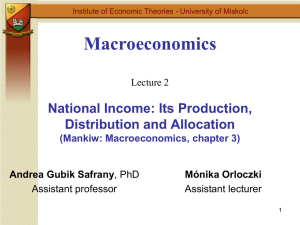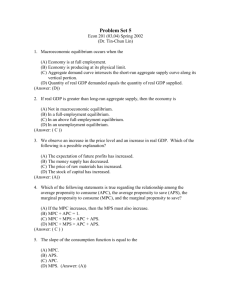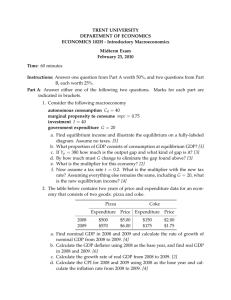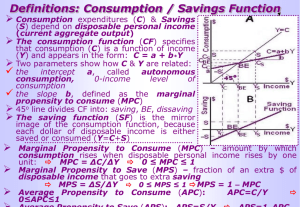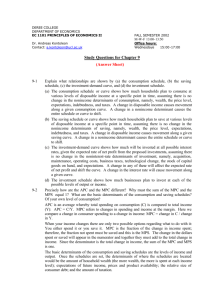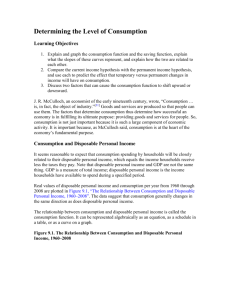Assignment 2 (part 1)
advertisement
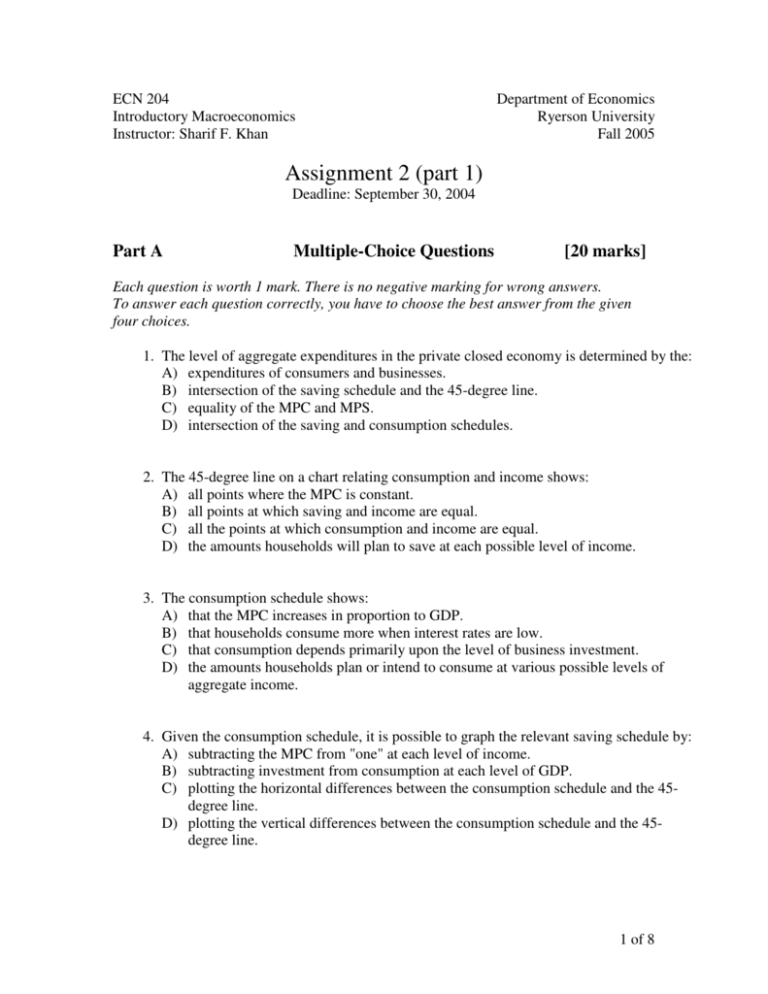
ECN 204 Introductory Macroeconomics Instructor: Sharif F. Khan Department of Economics Ryerson University Fall 2005 Assignment 2 (part 1) Deadline: September 30, 2004 Part A Multiple-Choice Questions [20 marks] Each question is worth 1 mark. There is no negative marking for wrong answers. To answer each question correctly, you have to choose the best answer from the given four choices. 1. The level of aggregate expenditures in the private closed economy is determined by the: A) expenditures of consumers and businesses. B) intersection of the saving schedule and the 45-degree line. C) equality of the MPC and MPS. D) intersection of the saving and consumption schedules. 2. The 45-degree line on a chart relating consumption and income shows: A) all points where the MPC is constant. B) all points at which saving and income are equal. C) all the points at which consumption and income are equal. D) the amounts households will plan to save at each possible level of income. 3. The consumption schedule shows: A) that the MPC increases in proportion to GDP. B) that households consume more when interest rates are low. C) that consumption depends primarily upon the level of business investment. D) the amounts households plan or intend to consume at various possible levels of aggregate income. 4. Given the consumption schedule, it is possible to graph the relevant saving schedule by: A) subtracting the MPC from "one" at each level of income. B) subtracting investment from consumption at each level of GDP. C) plotting the horizontal differences between the consumption schedule and the 45degree line. D) plotting the vertical differences between the consumption schedule and the 45degree line. 1 of 8 Use the following to answer questions 5-6: 5. Refer to the above diagram for a private closed economy. Consumption will be equal to income (GDP) at: A) some income level greater than D. B) income level A. C) income level D. D) income level B. 6. Refer to the above diagram for a private closed economy. At point F, the level of consumption will be equal to: A) GH + FC. B) B + FC. C) FC + C. D) C - FC. 7. The equation C = 35 + .75Y, where C is consumption and Y is disposable income, tells us that: A) households will consume three-fourths of whatever level of disposable income they receive. B) households will consume $35 if their disposable income is zero and will consume three-fourths of any increase in disposable income they receive. C) there is an inverse relationship between disposable income and consumption. D) households will save $35 if their disposable income is zero and will consume threefourths of any increase in disposable income they receive. 8. If the equation C = 20 + .6Y, where C is consumption and Y is disposable income, were graphed: A) the vertical intercept would be +.6 and the slope would be +20. B) it would reveal an inverse relationship between consumption and disposable income. C) the vertical intercept would be negative, but consumption would increase as disposable income rises. D) the vertical intercept would be +20 and the slope would be +.6. 2 of 8 9. Which of the following will not cause the consumption schedule to shift? A) a sharp increase in the amount of wealth held by households B) a change in consumer incomes C) the expectation of a recession D) a growing expectation that consumer durables will be in short supply 10. An increase in personal taxes will shift: A) both the consumption and saving schedules downward. B) both the consumption and saving schedules upward. C) the consumption schedule upward and the saving schedule downward. D) the consumption schedule downward and the saving schedule upward. 11. The investment-demand curve suggests: A) that the amount invested will not be affected by changes in the real interest rate. B) an inverse relationship between the real rate of interest and the level of investment spending. C) that an increase in business taxes will tend to stimulate investment spending. D) a direct relationship between the real rate of interest and the level of investment spending. 12. The immediate determinants of investment spending are the: A) expected rate of return on capital goods and the real interest rate. B) level of saving and the real interest rate. C) marginal propensity to consume and the real interest rate. D) interest rate and the expected price level. 13. A rightward shift of the investment-demand curve might be caused by: A) an increase in the price level. B) a decline in the real interest rate. C) an increase in the expected rate of return from investment. D) an increase in business taxes. 14. When we draw an investment demand curve we hold constant all of the following except: A) the expected rate of return from the investment. B) business taxes. C) the interest rate. D) the present stock of capital goods. 3 of 8 Use the following to answer question 15: Assume that for the entire business sector of the economy there is $0 worth of investment projects which will yield an expected rate of return of 25 percent or more. But there are $15 worth of investments which will yield an expected rate of return of 20-25 percent; another $15 with an expected rate of return of 15-20 percent; and similarly an additional $15 of investment projects in each successive rate of return range down to and including the 0-5 percent range. 15. Refer to the above information. If the real interest rate is 15 percent, what amount of investment will be undertaken? A) $15 B) $30 C) $45 D) $60 Use the following to answer question 16: 16. Refer to the above diagrams. Other things equal, an interest rate increase will: A) shift curve A to the right and shift curve B upward. B) shift curve A to the left and shift curve B downward. C) leave curve A in place but shift curve B downward. D) leave curve A in place but shfit curve A upward. 4 of 8 Use the following to answer questions 17-18: 17. Refer to the above diagram which applies to a private closed economy. If gross investment is Ig1, the equilibrium GDP and the level of consumption will be: A) H and HB respectively. B) J and JI respectively. C) J and JK respectively D) H and HF respectively. 18. Refer to the above diagram which applies to a private closed economy. If gross investment increases from Ig1 to Ig2, the equilibrium GDP will: A) decrease by KD. B) increase by HJ. C) increase by KD. D) increase by GH. 5 of 8 19. Which aggregate expenditure schedule AE in the diagram for a private closed economy implies the largest MPC? A) B) C) D) AE4 AE3 AE2 AE1 Use the following to answer question 20: 20. Refer to the above diagram for a private closed economy. The equilibrium level of GDP in this economy: A) is $60 billion. B) is $180 billion. C) is between $60 and $180 billion. D) cannot be determined from the information given. 6 of 8 Part B True/False/Uncertain Questions [30 marks] Each question is worth 10 marks. Explain why the following statement is True, False, or Uncertain according to economic principles. Use diagrams and / or numerical examples where appropriate. Unsupported answers will receive no marks. It is the explanation that is important. B1. In an economy saving equals planned investment B2. MPC is the fraction of the total income consumed. B3. In a private closed economy, an increase in real interest rate will lead to a higher level of equilibrium real GDP. 7 of 8 Part Part C Problem Solving Question [50 marks] Answer all parts of the following two questions. C-1 [25 marks] Assume the consumption schedule for a private closed economy is such that C = 50 + 0.8Y. Assume further that planned investment is independent of the level of income and constant at Ig=30. a. Plot the consumption, investment and aggregate expenditure schedules. Show the equilibrium point and the equilibrium level of real GDP in the graph. [10] b. Calculate the equilibrium level of income for this economy. Check your work by expressing the consumption, investment schedules in tabular form and determining the equilibrium GDP. [10] b. What will happen to equilibrium Y if Ig changes to 10? [5] C-2 [25 marks] Complete the table below. Level of output And income (GDP = DI) Consumption $240 260 280 300 320 340 360 380 400 $ _____ $ _____ $ _____ $ _____ $ _____ $ _____ $ _____ $ _____ $ _____ Saving APC APS MPC MPS $-4 0 4 8 12 16 20 24 28 _____ _____ _____ _____ _____ _____ _____ _____ _____ _____ _____ _____ _____ _____ _____ _____ _____ _____ _____ _____ _____ _____ _____ _____ _____ _____ _____ _____ _____ _____ _____ _____ _____ _____ _____ _____ a. Show the consumption and saving schedules graphically. [10] b. Locate the break-even level of income. How is it possible for households to dissave at very low income levels? [5] c. If the proportion of total income consumed decreases and the proportion saved increases as income rises, explain both verbally and graphically how the MPC and MPS can be constant at various levels of income. [10] 8 of 8

